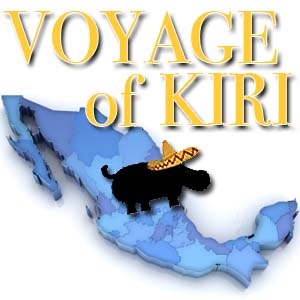As the overland Voyage of the Kiri commences, I approach the Mexican border but on the way south learns about the Aztecs and water in separate Los Angeles exhibitions.
Location:At a friend’s cottage near Point Loma in San Diego. From the deck, they point out the fuzzy hills of Tijuana in the distance.
Conditions: Clouds dissipating after a light rain this morning.
Discussion: We climb a hill and BAM! We can see Mexico far away. We are in San Diego on the brink of the journey. “We” being El Hippo the silver Ford van, my sweetheart, Alyssum, who is joining us for a month, and myself.
In a way, the trip has already begun — via a few chance encounters on the drive south through Los Angeles. Banners on the side of Sunset Boulevard advertised two events that we couldn’t miss: “The Aztec Pantheon” at the Getty Villa and “Water: Our Thirsty World,” an exhibit at the Annenberg Space for Photography. Both events were free!

We squeezed El Hippo into the tight Century City parking structure for the “Water” exhibit. Done in partnership with National Geographic, which is running a special edition this month on the “world’s impending fresh water crisis,” the exhibit captured dramatic feelings: women in Kenya carrying 100 pounds of water daily for five hours; melting glaciers in the Himalayas causing floods in Bangladesh; water conflicts in the Middle East intensifying religious struggle.
Just when you think the problems are only afar, we were blasted with Southern California’s pipe dream: piping water from as far away as the Colorado River to turn a desert into an urban oasis. And we were reminded of the precarious situation of the Sacramento Delta, another critical water supply affected by climate change, which is becoming more fickle due to early snowpack melt and the potential for increased salt water intrusion.
No wonder people are worried. My friend Kate, who we joined for breakfast on an organic farm in Ojai, just before arriving in L.A., told us about the 4th World Water Forum held in Mexico City in 2006. “I was constructing wetlands in the Yucatan, so I was invited to come,” she said. “A lot of indigenous people heard about it, too, and came to participate. Some of them walked from very far away but were not let in.”
Water is a big deal, but especially to those who don’t have it.
What about climate change? “A Peruvian indigenous group recently visited us here in Ojai,” Kate continued. “They didn’t have a science education, but they were very clear about something. They said, ‘The climate is changing; we are trying to listen to Mother Earth, but it is harder to grow crops. Things are unpredictable.'”
I thought about Mexico, and I wondered if farmers there are experiencing similar challenges.
Just before leaving L.A., we paid a visit to the Getty Villa in Malibu for the Aztec art exhibit. It was like a lens to a brutal and magical culture. They lived in our voyage’s destination: Oaxaca and neighboring areas. The sculptures of deities and demons were crowd pleasers, but I wondered about the Florentine Codex, a huge volume compiled by a Franciscan friar capturing Aztec culture and knowledge. Aside from human sacrifices and polytheistic rituals, what might it reveal about our water and climate crisis, if anything? I committed myself to studying more Aztec culture once I arrive in Oaxaca.
After a few lovely hours in traffic, we pulled into San Diego. We are now poised to embark on the voyage — but first I have some discoveries to make. I set up a meeting with the San Diego Coastkeeper later this evening to understand the “Tijuana situation.”





